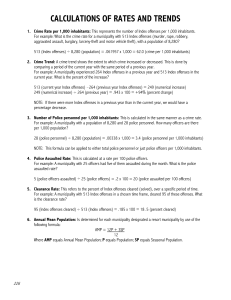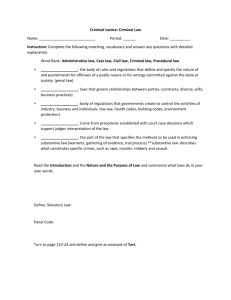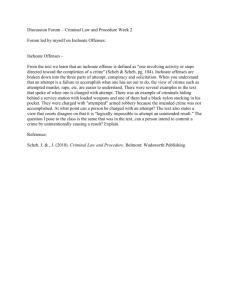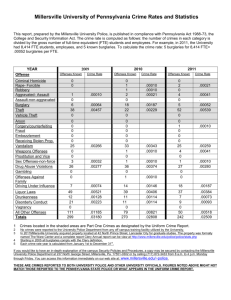GLOSSARY OF TERMS
advertisement
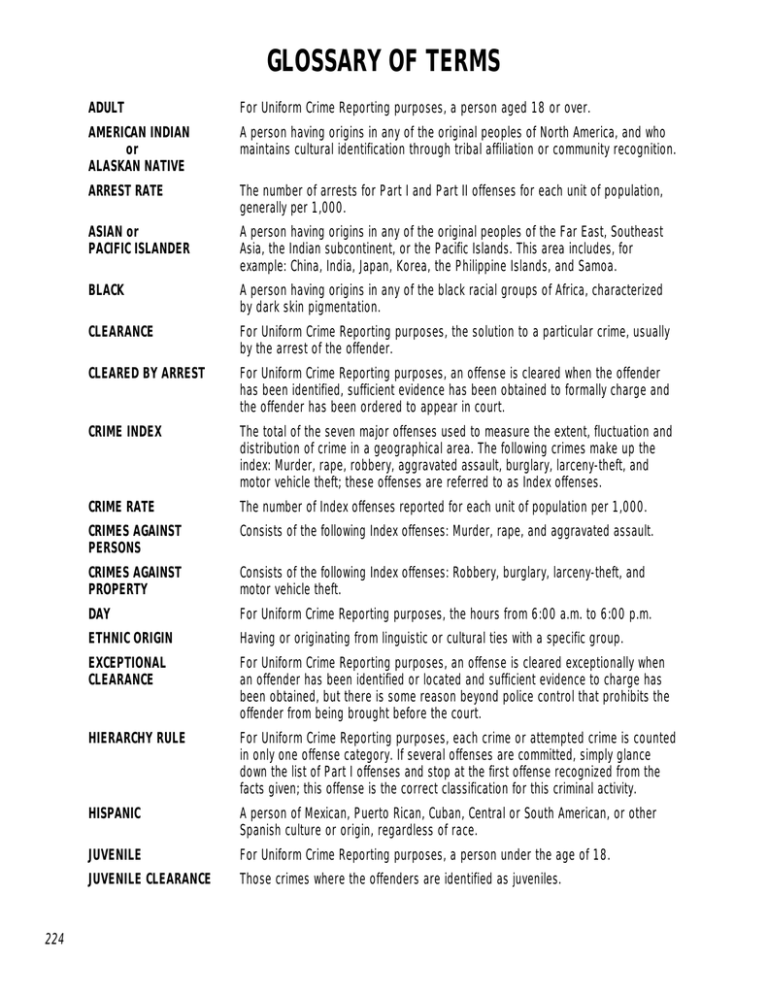
GLOSSARY OF TERMS 224 ADULT For Uniform Crime Reporting purposes, a person aged 18 or over. AMERICAN INDIAN or ALASKAN NATIVE A person having origins in any of the original peoples of North America, and who maintains cultural identification through tribal affiliation or community recognition. ARREST RATE The number of arrests for Part I and Part II offenses for each unit of population, generally per 1,000. ASIAN or PACIFIC ISLANDER A person having origins in any of the original peoples of the Far East, Southeast Asia, the Indian subcontinent, or the Pacific Islands. This area includes, for example: China, India, Japan, Korea, the Philippine Islands, and Samoa. BLACK A person having origins in any of the black racial groups of Africa, characterized by dark skin pigmentation. CLEARANCE For Uniform Crime Reporting purposes, the solution to a particular crime, usually by the arrest of the offender. CLEARED BY ARREST For Uniform Crime Reporting purposes, an offense is cleared when the offender has been identified, sufficient evidence has been obtained to formally charge and the offender has been ordered to appear in court. CRIME INDEX The total of the seven major offenses used to measure the extent, fluctuation and distribution of crime in a geographical area. The following crimes make up the index: Murder, rape, robbery, aggravated assault, burglary, larceny-theft, and motor vehicle theft; these offenses are referred to as Index offenses. CRIME RATE The number of Index offenses reported for each unit of population per 1,000. CRIMES AGAINST PERSONS Consists of the following Index offenses: Murder, rape, and aggravated assault. CRIMES AGAINST PROPERTY Consists of the following Index offenses: Robbery, burglary, larceny-theft, and motor vehicle theft. DAY For Uniform Crime Reporting purposes, the hours from 6:00 a.m. to 6:00 p.m. ETHNIC ORIGIN Having or originating from linguistic or cultural ties with a specific group. EXCEPTIONAL CLEARANCE For Uniform Crime Reporting purposes, an offense is cleared exceptionally when an offender has been identified or located and sufficient evidence to charge has been obtained, but there is some reason beyond police control that prohibits the offender from being brought before the court. HIERARCHY RULE For Uniform Crime Reporting purposes, each crime or attempted crime is counted in only one offense category. If several offenses are committed, simply glance down the list of Part I offenses and stop at the first offense recognized from the facts given; this offense is the correct classification for this criminal activity. HISPANIC A person of Mexican, Puerto Rican, Cuban, Central or South American, or other Spanish culture or origin, regardless of race. JUVENILE For Uniform Crime Reporting purposes, a person under the age of 18. JUVENILE CLEARANCE Those crimes where the offenders are identified as juveniles. NIGHT For Uniform Crime Reporting purposes, the hours from 6:00 p.m. to 6:00 a.m. NONVIOLENT CRIME Consists of the following Index offenses: Burglary, larceny-theft, and motor vehicle theft. POPULATION Is the year-round population of the municipality shown in the most recent State population estimates published by the Department of Labor, except that in the year of promulgation of a Federal decennial census, the census figures shall be used. RESORT MUNICIPALITY Is a municipality which, because of itss recreational, entertainment or amusement characteristics or facilities or its close proximity to such characteristics or facilities, experiences a total increase during the seasonal period in the number of persons temporarily resident therein of 25 percent or more of its population. SEASONAL POPULATION Is the average of the estimated number of persons temporarily resident in the municipality during the three consecutive months when the temporary population is greatest. TEMPORARY RESIDENT Means the occupying for any period of time during the seasonal period by any person not counted as a resident of the municipality for population purposes of an accommodation in a rented residential unit or vacation home. UNFOUNDED Classification of reported crimes that are found to be false or baseless. VIOLENT CRIME Consists of the following Index offenses: Murder, rape, robbery, and aggravated assault. WHITE A person having origins in any of the original peoples of Europe, North Africa, or the Middle East. 225 CALCULATIONS OF RATES AND TRENDS 1. Crime Rate per 1,000 inhabitants: This represents the number of Index offenses per 1,000 inhabitants. For example: What is the crime rate for a municipality with 513 Index offenses (murder, rape, robbery, aggravated assault, burglary, larceny-theft and motor vehicle theft), with a population of 8,280? 513 (Index offenses) ÷ 8,280 (population) = .061957 x 1,000 = 62.0 (crime per 1,000 inhabitants) 2. Crime Trend: A crime trend shows the extent to which crime increased or decreased. This is done by comparing a period of the current year with the same period of a previous year. For example: A municipality experienced 264 Index offenses in a previous year and 513 Index offenses in the current year. What is the percent of the increase? 513 (current year Index offenses) 264 (previous year Index offenses) = 249 (numerical increase) 249 (numerical increase) ÷ 264 (previous year) = .943 x 100 = +94% (percent change) NOTE: If there were more Index offenses in a previous year than in the current year, we would have a percentage decrease. 3. Number of Police personnel per 1,000 inhabitants: This is calculated in the same manner as a crime rate. For example: A municipality with a population of 8,280 and 28 police personnel. How many officers are there per 1,000 population? 28 (police personnel) ÷ 8,280 (population) = .00338 x 1,000 = 3.4 (police personnel per 1,000 inhabitants) NOTE: This formula can be applied to either total police personnel or just police officers per 1,000 inhabitants. 4. Police Assaulted Rate: This is calculated at a rate per 100 police officers. For example: A municipality with 25 officers had five of them assaulted during the month. What is the police assaulted rate? 5 (police officers assaulted) ÷ 25 (police officers) = .2 x 100 = 20 (police assaulted per 100 officers) 5. Clearance Rate: This refers to the percent of Index offenses cleared (solved), over a specific period of time. For example: A municipality with 513 Index offenses in a chosen time frame, cleared 95 of these offenses. What is the clearance rate? 95 (Index offenses cleared) ÷ 513 (Index offenses) = .185 x 100 = 18 .5 (percent cleared) 6. Annual Mean Population: Is determined for each municipality designated a resort municipality by use of the following formula: AMP = 12P + 3SP 12 Where AMP equals Annual Mean Population; P equals Population; SP equals Seasonal Population. 226
